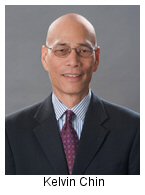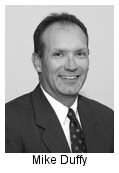LSSO Conference: Boosting Revenue with Client Teams
 How can you tell if a client team is working? Key indicators are:
How can you tell if a client team is working? Key indicators are:
- A satisfied client.
- An increase in the number of relationships at the client.
- More revenue from the client.
This was the considered view of a panel of in-house law firm business development experts speaking at the Legal Sales and Service Organization (LSSO) annual RainDance conference Chicago. They included:
- Mike Duffy, Director of Client Services at King & Spalding. He works exclusively on client team management
- Linda L. Fleming, Esq., former Director of Business Development at Buchanan Ingersoll. She is the firm's key account training professional.
- Kelvin Chin, a sales director at Womble Carlyle. He has been at the 500-lawyer firm only 9 months, but has sold to GCs for more than 20 years in other jobs.
- Patrick Fuller, Managing Account Director for Hubbard One, who moderated the panel.
 Fleming and Chin said that the key measurement is client satisfaction. Chin said Womble will conduct 100 client surveys in 2010 -- 40 done personally by the firm's chairman. "It's difficult to get the chair to find the time, but we're committed to it," he said. "I'm a results-oriented guy. I will ask 'is the client really happy?' "Are we bringing in more work from them?' and 'Is the client willing to go to bat for us and give us a really good reference.' That would be a signature of success."
Fleming and Chin said that the key measurement is client satisfaction. Chin said Womble will conduct 100 client surveys in 2010 -- 40 done personally by the firm's chairman. "It's difficult to get the chair to find the time, but we're committed to it," he said. "I'm a results-oriented guy. I will ask 'is the client really happy?' "Are we bringing in more work from them?' and 'Is the client willing to go to bat for us and give us a really good reference.' That would be a signature of success."
To measure success, Duffy meets regularly with the relationship partner on a client team and delivers a complete financial report with an analysis: revenue growth, revenue per lawyer, write-offs, the number of practice groups and offices serving a client and more. "We also track whom we know at the client, create a relationship map (connecting a lawyer with a person at the client) and I ask if we're touching each one regularly."
Duffy also establishes client pursuit teams to go after prospective clients. He asks each practice group leader to name five prospective clients, and narrows the total down to 35 clients. The firm appoints a partner to head up the team to pursue them from 18 to 24 months -- or even longer.
Rewarding client teams for their successes is difficult. Business developers have no way to change the firm's compensation system or alter existing compensation credits. But the panelists said they had found a more effective reward the money: recognition.
Duffy said, "I always ask, 'how can I make the team members look good?'" Fleming agreed, saying, "having a team publicly acclaimed for what they did is more valuable than anything else you could do for them. She recommended that business development professionals read the book Drive: The Surprising Truth About What Motivates Us by Daniel H. Pink (about $16 on Amazon.com).
The speakers agreed that client teams will continue to be a key part of business development for years to come. Duffy said, "First, the results prove the value of client teams. Second, clients want them." Chin agreed, saying, " Clients are demanding that more attention be focused on them."
"Our client interviews have led me to conclude that it's good to give clients good service, but they are also looking for something extra -- creativity and innovation. Without a client team, you can't achieve that."



